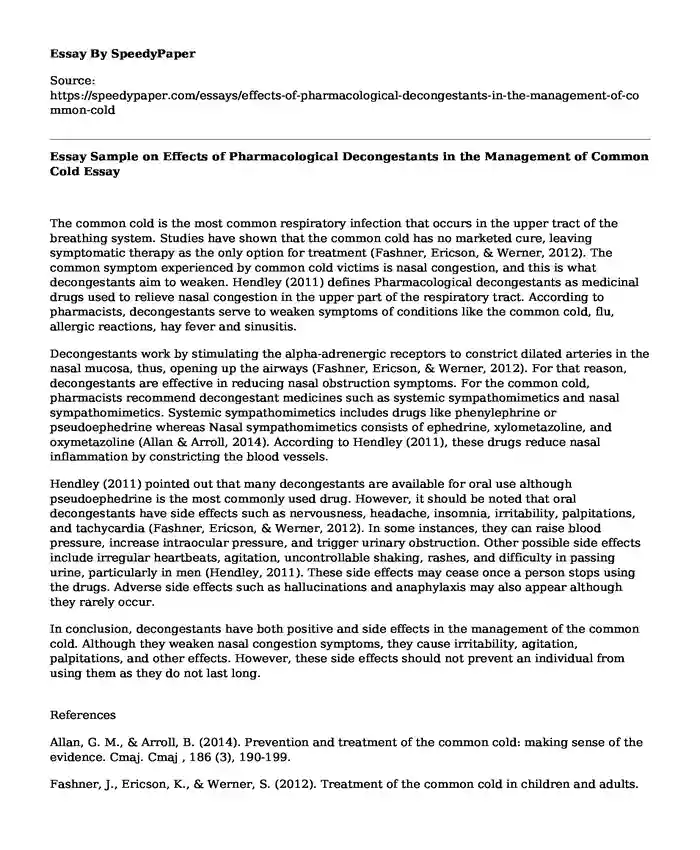
| Type of paper: | Essay |
| Categories: | Medicine Pharmacology |
| Pages: | 2 |
| Wordcount: | 392 words |
The common cold is the most common respiratory infection that occurs in the upper tract of the breathing system. Studies have shown that the common cold has no marketed cure, leaving symptomatic therapy as the only option for treatment (Fashner, Ericson, & Werner, 2012). The common symptom experienced by common cold victims is nasal congestion, and this is what decongestants aim to weaken. Hendley (2011) defines Pharmacological decongestants as medicinal drugs used to relieve nasal congestion in the upper part of the respiratory tract. According to pharmacists, decongestants serve to weaken symptoms of conditions like the common cold, flu, allergic reactions, hay fever and sinusitis.
Decongestants work by stimulating the alpha-adrenergic receptors to constrict dilated arteries in the nasal mucosa, thus, opening up the airways (Fashner, Ericson, & Werner, 2012). For that reason, decongestants are effective in reducing nasal obstruction symptoms. For the common cold, pharmacists recommend decongestant medicines such as systemic sympathomimetics and nasal sympathomimetics. Systemic sympathomimetics includes drugs like phenylephrine or pseudoephedrine whereas Nasal sympathomimetics consists of ephedrine, xylometazoline, and oxymetazoline (Allan & Arroll, 2014). According to Hendley (2011), these drugs reduce nasal inflammation by constricting the blood vessels.
Hendley (2011) pointed out that many decongestants are available for oral use although pseudoephedrine is the most commonly used drug. However, it should be noted that oral decongestants have side effects such as nervousness, headache, insomnia, irritability, palpitations, and tachycardia (Fashner, Ericson, & Werner, 2012). In some instances, they can raise blood pressure, increase intraocular pressure, and trigger urinary obstruction. Other possible side effects include irregular heartbeats, agitation, uncontrollable shaking, rashes, and difficulty in passing urine, particularly in men (Hendley, 2011). These side effects may cease once a person stops using the drugs. Adverse side effects such as hallucinations and anaphylaxis may also appear although they rarely occur.
In conclusion, decongestants have both positive and side effects in the management of the common cold. Although they weaken nasal congestion symptoms, they cause irritability, agitation, palpitations, and other effects. However, these side effects should not prevent an individual from using them as they do not last long.
References
Allan, G. M., & Arroll, B. (2014). Prevention and treatment of the common cold: making sense of the evidence. Cmaj. Cmaj , 186 (3), 190-199.
Fashner, J., Ericson, K., & Werner, S. (2012). Treatment of the common cold in children and adults. American family physician, 86 (2).
Hendley, J. O. (2011). The common cold and decongestant therapy. Pediatrics in Review, 32 (2), 47.
Cite this page
Essay Sample on Effects of Pharmacological Decongestants in the Management of Common Cold. (2022, Nov 14). Retrieved from https://speedypaper.com/essays/effects-of-pharmacological-decongestants-in-the-management-of-common-cold
Request Removal
If you are the original author of this essay and no longer wish to have it published on the SpeedyPaper website, please click below to request its removal:
- Personal Experience Essay Sample: An Embarrassing Moment at School
- Essay Sample with a Prediction Regarding the Future of the Global Economy
- HRM Essay Example: Dismissal Meeting
- Addiction to Social Media "Is Facebook Making Us Sad?" Free Essay
- Essay Sample on Servant Leadership, Emotional Intelligence, and Leadership Performance
- Goffman: Priming for College and Prison. Free Essay
- Essay Sample on Abortion Rights - Social Issues
Popular categories




